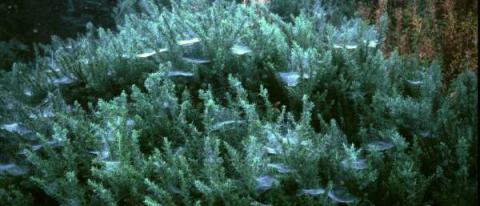
One of the wonders of spiders is their ability to spin silk, a material that is, weight for weight, stronger than steel and Kevlar(tm). Silk is a 'fibroin' or 'structure' protein; rich in the amino acid cystine that gives the silk its strength. It is secreted by special glands at the end of the abdomen and is used for many purposes. Females bundle their eggs in sacs of silk to carry them around and protect them from predators and parasites. Males use it to form a platform on which they deposit sperm in order that they can charge their palps prior to mating. It is used to build retreats in which to hide, moult, lay eggs, aestivate and rest. Strands are used to make trip lines for detecting prey. Silken guidelines are secreted as the spider roams and can act as a lifeline should the spider fall or drop to safety when disturbed. Most familiar of all uses is in the production of silken snares and traps for prey.
Retreats and traps are as varied as the spiders that make them. In Britain, our only relative of the so-called 'bird-eating spiders' or 'tarantulas', the Purse Web spider (Atypus affinis) digs a hole in soft soil which it lines with silk. The silken lining is extended along the surface of the soil and covered in pieces of leaves, soil and other debris, forming a structure like the finger of a glove. Insects walking or landing on this are caught by the spider inside. Trap-door spiders found in other parts of the world build similar lairs but fitted with lids behind which they hide. They wait for passing prey, which they detect by laying down silken threads radiating from the top of the tunnel across the ground.
Tunnel retreats are constructed by several other species. Amaurobius fenestralis produces inter-woven threads that lead to a silken retreat in cracks in walls and tree bark. Segestria has a similar web but with the addition of tough silken strands radiating from the lair which act as detection trip lines in a manner similar to that used by trap-door spiders.
Forgetting to dust the top of a corner cabinet in the kitchen can provide an ideal home for the House Spider, Tegenaria domestica. This spider spins an elaborate silken retreat with a silken platform extending from the entrance. Agelena labyrinthica, an outdoor cousin of Tegenaria, has a similar retreat but, in addition, produces vertical strands that detect prey that touch them, sending vibrations to the spider hiding below.
Webs come in various other shapes and sizes including triangular webs, tangle webs and sheet webs that resemble silken hammocks. Amongst grass and low bushes, tangled silken threads bespeckled with morning dew are a common site in late summer and autumn. These are the webs of 'money spiders', Linyphiidae. The spider sits beneath a silken platform from which a tangle of silken strands extends above and below. Prey blundering into these lines are detected and caught.
Indoors, the Daddy-Long-legs Spider, Pholcus phalangioides, makes random fine silken tangle webs. This spider prefers to make webs behind furniture and in the corners of ceilings. Dictyna builds tangled webs in dead, dried flower heads and other places.
Some webs are unusual. The rare Triangle Spider, Hyptiotes, spins a silken triangular web resembling a portion of a circular orb-web. It then cuts the apex of the triangle and holds it tight. When an insect flies into the web, Hyptiotes slackens it so that it forms a net and then tightens it to entangle its victim. It then wraps its prey prior to eating it.
Of all the webs, the silken orb is the most spectacular. Spiders belonging to several families of spider spin webs of this type. The Uloboridae, to which Hypiotes belongs, spin orb webs with a central band of silk, called the stabilmentum. Such structures are also produced in the typical orb spinners, which include the Garden Spider, the Araneidae. In these webs, the centre, or hub of the web is closed. In the Tetragnathidae, the hub is open. The tiny incomplete orbs of the ray spiders, Theridosomatidae, completely lack a hub. The Wasp Spider, Argiope bruennichi, spins an orb webs with a central band of silk called the stabilmentum.
Catch and Keep a Web
Webs can be obvious to the eye but by simply spraying water from a mister (any old sprayer, e.g. from a car de-icer, furniture spray etc. will do) onto vegetation will show up many more webs than can be detected by initial inspection by eye. You can preserve a web by gently spraying it with paint. Be careful select a web that is unoccupied! Spray gently then place a piece of paper behind the web and lift the paper so that it touches the web. Continue lifting in order to break the web's supporting strands. With luck the sprayed web will stick to the paper and be visible. For additional protection, spray the web and paper with a thin coat of lacquer (hair spray will do, but you'll have scented web!)
